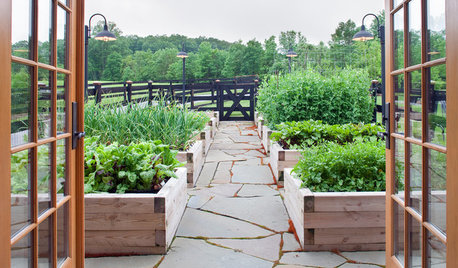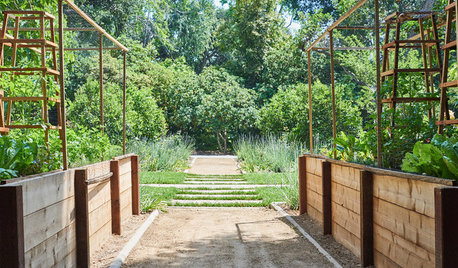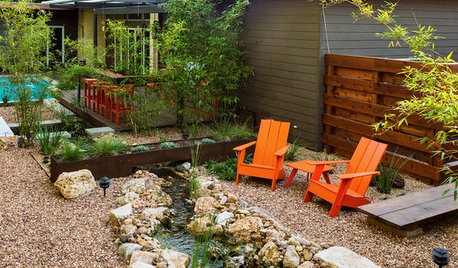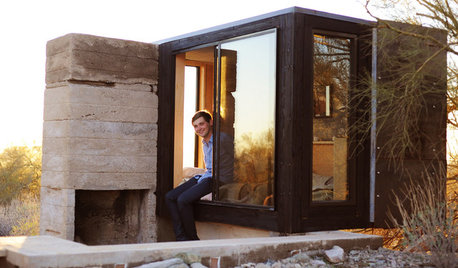Drainage for beds in claysoil
claytamer
15 years ago
Related Stories

FARM YOUR YARDRaised Beds for Every Garden Style
There’s a raised bed design for every landscape, from traditional to contemporary
Full Story
LANDSCAPE DESIGNDitch the Ordinary Ditch: Create a Realistic Dry Creek Bed
Here’s how to turn your water runoff system into an eye-catching accent for your landscape
Full Story
GARDENING GUIDES8 Materials for Raised Garden Beds
Get the dirt on classic and new options for raised vegetable and plant beds, to get the most from your year-round garden
Full Story
EDIBLE GARDENS7 Tips to Ensure Success With Raised Bed Gardening
Raised bed gardening is a favorite for edible plants. Here’s how to get it right
Full Story
LANDSCAPE DESIGN4 Gardens With Creative, Earth-Friendly Drainage Solutions
See how designers have made the most of site conditions to manage runoff, catch rainwater and more
Full Story
FARM YOUR YARDHow to Build a Raised Bed for Your Veggies and Plants
Whether you’re farming your parking strip or beautifying your backyard, a planting box you make yourself can come in mighty handy
Full Story
CRAFTSDIY Project: Vintage Suitcase Dog Bed
Save Your Own Furniture With a Comfy Dog Bed You Can Make This Weekend
Full Story
BATHROOM DESIGNConvert Your Tub Space Into a Shower — Waterproofing and Drainage
Step 4 in swapping your tub for a sleek new shower: Pick your waterproofing materials and drain, and don't forget to test
Full Story
SMALL HOMESHouzz Tour: A Student's Bed-Size Shelter in the Arizona Desert
Could you sleep in such a small space just above the desert floor? One Taliesin architecture student at a time does just that
Full Story
SPRING GARDENINGInspiring Raised Beds for Fall and Spring Planting
Make Your Next Vegetable Garden Even Better with Beautiful Boxes and Paths
Full Story





engineeredgarden
Dan _Staley (5b Sunset 2B AHS 7)
Related Professionals
Damascus Landscape Contractors · Darien Landscape Contractors · Mesa Landscape Contractors · Maple Heights Landscape Contractors · Jacksonville Fence Contractors · Berkeley Fence Contractors · Guilford Fence Contractors · Lockport Fence Contractors · Palm Harbor Fence Contractors · Palo Alto Fence Contractors · Short Pump Fence Contractors · Skokie Fence Contractors · Spanaway Fence Contractors · Tavares Fence Contractors · Verona Fence Contractorstapla (mid-Michigan, USDA z5b-6a)
tapla (mid-Michigan, USDA z5b-6a)
Dan _Staley (5b Sunset 2B AHS 7)
claytamerOriginal Author
pvel
tapla (mid-Michigan, USDA z5b-6a)
pvel
tapla (mid-Michigan, USDA z5b-6a)
rj_hythloday
tapla (mid-Michigan, USDA z5b-6a)
kristimama
tapla (mid-Michigan, USDA z5b-6a)
kristimama
snowmanaxp
tapla (mid-Michigan, USDA z5b-6a)
pvel
tapla (mid-Michigan, USDA z5b-6a)
snowmanaxp
tapla (mid-Michigan, USDA z5b-6a)
Dan _Staley (5b Sunset 2B AHS 7)
eaglesgarden
tapla (mid-Michigan, USDA z5b-6a)
sinfonian
tapla (mid-Michigan, USDA z5b-6a)
Dan _Staley (5b Sunset 2B AHS 7)
jeremyjs
Dan _Staley (5b Sunset 2B AHS 7)
jeremyjs
pvel
tapla (mid-Michigan, USDA z5b-6a)
pvel